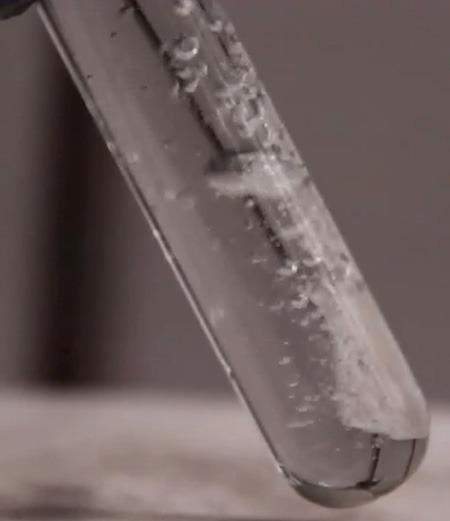Aluminum is a highly reactive metal that can remove oxygen from water molecules to produce hydrogen gas. Its extensive use in products that are exposed to wetness poses no danger because aluminum immediately reacts with air to obtain a coating of aluminum oxide, which obstructs further reactions.
 Bubbles of hydrogen gas are generated from the reaction of water with an aluminum-gallium composite. Movies of the reaction are available online. (Image Credit: Amberchan et al., Applied Nano Materials 2022)
Bubbles of hydrogen gas are generated from the reaction of water with an aluminum-gallium composite. Movies of the reaction are available online. (Image Credit: Amberchan et al., Applied Nano Materials 2022)
For a number of years, scientists have attempted to discover efficient and economical ways to use aluminum’s reactivity to produce clean hydrogen fuel. A new study by scientists at the University of California Santa Cruz (UCSC) demonstrates that an easily created composite of aluminum and gallium generates aluminum nanoparticles that react quickly with water at room temperature to produce large quantities of hydrogen.
The gallium was recovered without difficulty for reuse after the reaction, which produces 90% of the hydrogen that could supposedly be created from the reaction of all the aluminum present in the composite.
We don’t need any energy input, and it bubbles hydrogen-like crazy. I’ve never seen anything like it.
Scott Oliver, Corresponding Author and Professor of Chemistry, University of California Santa Cruz
Oliver and Bakthan Singaram, professors of chemistry and biochemistry, are corresponding authors of a study, which was published in the February 14th issue of Applied Nano Materials.
The reaction of gallium and aluminum with water has been well-known since the 1970s, and videos of it can be easily found online. It is effective because gallium, a liquid at just above ambient temperature, eliminates the passive aluminum oxide coating, allowing direct contact of aluminum with water. The new research, however, has adopted many innovations and unique findings that could pave the way to practical applications.
A U.S. patent application is awaited for this technology.
Singaram said the research concept developed out of a conversation he had with a student, co-author Isai Lopez, who had watched some videos and began experimenting with aluminum-gallium hydrogen production in his home kitchen.
He wasn’t doing it in a scientific way, so I set him up with a graduate student to do a systematic study. I thought it would make a good senior thesis for him to measure the hydrogen output from different ratios of gallium and aluminum.
Bakthan Singaram, Corresponding Author and Professor of Chemistry and Biochemistry, University of California Santa Cruz
Earlier studies had generally used aluminum-rich mixtures of gallium and aluminum or in some instances more complex alloys. But Singaram’s lab discovered that hydrogen production improved with a gallium-rich composite. In fact, the production rate of hydrogen was so surprisingly high; the scientists realized there must be something profoundly novel about this gallium-rich alloy.
Oliver proposed that the development of aluminum nanoparticles could be responsible for the increased production of hydrogen, and his lab had the equipment necessary for nanoscale characterization of the alloy.
Using scanning electron microscopy and X-Ray diffraction, the scientists demonstrated the development of aluminum nanoparticles in a 3:1 gallium-aluminum composite, which they found to be the ideal ratio for hydrogen manufacture.
In this gallium-abundant composite, the gallium is accountable for both dissolving the aluminum oxide coating and separating the aluminum into nanoparticles.
The gallium separates the nanoparticles and keeps them from aggregating into larger particles. People have struggled to make aluminum nanoparticles, and here we are producing them under normal atmospheric pressure and room temperature conditions.
Bakthan Singaram, Corresponding Author and Professor of Chemistry and Biochemistry, University of California Santa Cruz
The composite creation required only simple manual mixing.
Our method uses a small amount of aluminum, which ensures it all dissolves into the majority gallium as discrete nanoparticles. This generates a much larger amount of hydrogen, almost complete compared to the theoretical value based on the amount of aluminum. It also makes gallium recovery easier for reuse.
Scott Oliver, Corresponding Author and Professor of Chemistry, University of California Santa Cruz
The composite can be produced with easily available sources of aluminum, including used cans or foil, and the composite can be stored for extended periods by covering it with cyclohexane to guard it against moisture.
Although gallium is not plentiful and is comparatively expensive, it can be recovered and reused numerous times without sacrificing its effectiveness, Singaram said. It still is to be seen, however, if this process can be expanded to be practical for commercial hydrogen production.
The first author of the study, Gabriella Amberchan is a graduate student in Singaram’s lab. Other co-authors of the research include Beatriz Ehlke, Jeremy Barnett, Neo Bao, and A’Lester Allen, all at UCSC. This study was partly assisted by funds from the Ima Hernandez Foundation.
Journal Reference:
Amberchan, G., et al. (2022) Aluminum Nanoparticles from a Ga–Al Composite for Water Splitting and Hydrogen Generation. Applied Nano Materials. doi.org/10.1021/acsanm.1c04331.